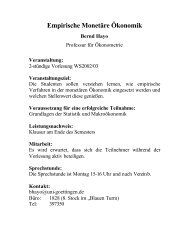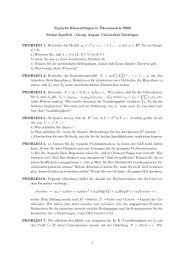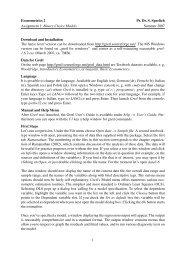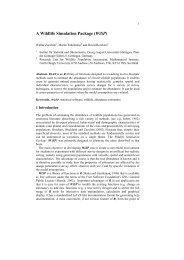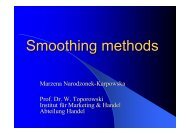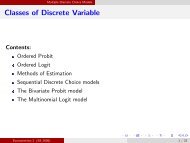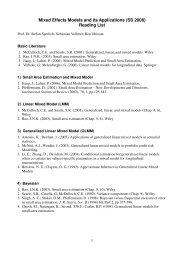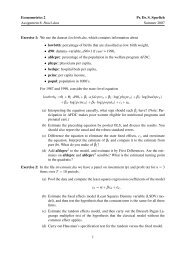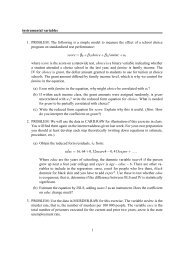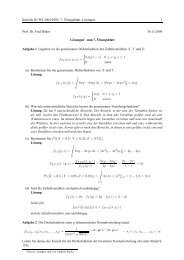Econometrics 2 Pr. Dr. S. Sperlich Assignment 4: Tobit Models ...
Econometrics 2 Pr. Dr. S. Sperlich Assignment 4: Tobit Models ...
Econometrics 2 Pr. Dr. S. Sperlich Assignment 4: Tobit Models ...
You also want an ePaper? Increase the reach of your titles
YUMPU automatically turns print PDFs into web optimized ePapers that Google loves.
<strong>Econometrics</strong> 2<br />
<strong>Pr</strong>. <strong>Dr</strong>. S. <strong>Sperlich</strong><br />
<strong>Assignment</strong> 4: <strong>Tobit</strong> <strong>Models</strong> Summer 2008<br />
(c) Use the results from (b) to estimate the difference in expected pension benefits<br />
for a white male and a nonwhite female, both of whom are 35 years old, single<br />
with no dependents, have 16 years of education and 10 years of experience.<br />
(d) Add union to the <strong>Tobit</strong> model and comment on its significance.<br />
(e) Apply the <strong>Tobit</strong> model from part (d) but with peratio, the pension-earnings<br />
ratio, as the dependent variable. (Notice that is a fraction between zero and one,<br />
but, while it often takes on the value zero, it never gets close to being unity.<br />
Thus, a <strong>Tobit</strong> model is fine as an approximation.) Does gender or race have an<br />
effect on the pension-earnings ratio?<br />
Exercise 4: Consider a double hurdle model of durable goods expenditure, where the purchase<br />
decision is represented by<br />
Y i1 = 1I Y ∗<br />
i1 >0<br />
but the actual amount purchased is represented by a censored regression model, thereby<br />
avoiding negativity of Y i2 . In this case<br />
Y i2 = Y i1 · max(0,Y ∗<br />
i2).<br />
One interpretation of this model is that observed demand Y i2 is zero either because<br />
an individual genuinely does not consume the good (that is, Yi1 ∗ ≤ 0), or because<br />
for some reason (infrequently of purchase, misreporting, etc.) zero expenditure was<br />
recorded (that is, Yi2 ∗ ≤ 0).<br />
(a) Determine P(Y i2 = 0) when Yi1 ∗ and Y i2 ∗ are independent.<br />
(b) Specify the sample log–likelihood.<br />
(c) What happens when P(Y i1 = 1) = 1 for all sample units?<br />
(d) Which other than the ML–estimator could we use for estimation?<br />
2



